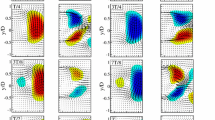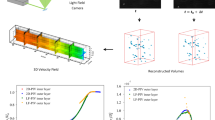Abstract
In this feasibility study the tomographic PIV technique has been applied to time resolved PIV recordings for the study of the growth of a turbulent spot in a laminar flat plate boundary layer and to visualize the topology of coherent flow structures within a tripped turbulent flat plate boundary layer flow. The experiments are performed around (Re x )1/2 ≈ 450 in a low speed wind-tunnel using four high speed CMOS cameras operating up to 5 kHz. The volume illumination required a multiple-reflection system able to intensify light intensity within the measurement volume. This aspect is deemed essential when a high-speed tomographic PIV system is applied in air flows. The particle image recordings are used for a three dimensional tomographic reconstruction of the light intensity distribution within the illuminated volume. Each pair of reconstructed three-dimensional light distributions is analyzed by 3D spatial cross-correlation using iterative multi-grid schemes with volume-deformation, yielding a correlated time sequence of three-dimensional instantaneous velocity vector volumes. The coherent structures organization is analyzed by 3D-vorticity and -swirling-strength iso-surfaces visualization. In both flow types streaks and hairpin-like or arch vortical structures are most prominent. The data gives insight into the role of these structures for the spatio-temporal arrangement of the wall normal flow exchange mechanisms, especially of the instantaneous Reynolds stress events Q2 and Q4. A description of different self-sustainable flow organizations based on modifications of the hairpin-vortex- and streak-models is given. Two preliminary results are essential: Self-sustainability of a coherent vortical structure depends on the ability to entrain high momentum fluid, initially Q4. And, stream-wise swirl at the near-wall region of arch or hairpin-like vortices has been observed to be rare.











Similar content being viewed by others
Abbreviations
- t :
-
time
- Vx, Vy, Vz:
-
instantaneous velocity components in x-, y- and z-direction
- V′x, V′y, V′z:
-
fluctuation velocity components
- x, y, z:
-
streamwise, normal and spanwise coordinates
- Re x :
-
Reynolds number based on length from plate LE
- T :
-
time-difference from excitation of spot
- f :
-
focal length
- f # :
-
aperture stop
- Q1,...,Q4:
-
Quadrants of instantaneous Reynolds stress V′xV′y
- U ∞ :
-
free-stream velocity
- δ :
-
boundary layer thickness (0.99 U ∞ )
- λ:
-
wave length of laser light
- |rot|:
-
magnitude of instantaneous vorticity
- PDF:
-
Probability density function
- RMS:
-
Root mean square
- (T)BL:
-
(Turbulent) Boundary-layer
- TE:
-
Trailing edge
- LE:
-
Leading edge
- TR:
-
Time resolved
References
Adrian RJ, Meinhardt CD, Tomkins CD (2000) Vortex organization in the outer region of the turbulent boundary layer. J Fluid Mech 422:1–54
Cantwell B, Coles D, Dimotakis P (1977) Structure and entrainment in the plane of symmetry of a turbulent spot. J Fluid Mech 87:641–672
Coles D, Savas O (1980) Interaction of regular patterns of turbulent spots in a laminar boundary layer. In: Fasel EA, Lam.-Turb. transition, IUTAM symposium, , pp 277–288
Doorne van CWH, Hof B, Lindken RH, Westerweel J, Dierksheide U (2005) Time resolved stereoscopic PIV in pipe flow. Visualizing 3D flow structures. In: Proceedings of 5th international symposium on particle image velocimetry, Busan, Korea, 22–24 September 2003
Elsinga GE, Wieneke B, Scarano F, van Oudheusden BW (2005) Assessment of tomo-PIV for three-dimensional flows. In: Proceedings of 6th international symposium on particle image velocimetry Pasadena, California, USA, 21–23 September 2005
Elsinga GE, Scarano F, Wieneke B, van Oudheusden BW (2006) Tomographic particle image velocimetry, experiments of fluids, 41(6), pp 933–947
Elsinga GE., Kuik DJ, Oudheusden BW, Scarano F (2007) Investigation of the three-dimensional coherent structures in a turbulent boundary layer with tomographic-PIV, AIAA 2007–1305; 45th AIAA aerospace sciences meeting and exhibition, 8–11 January 2007, Reno, Nevada
Emmons HW (1951) The laminar-turbulent transition in a boundary layer Part I. J Aeronaut Sci 18:490–498
Gad-el-Hak M, Blackwelder RF, Riley JJ (1981) On the growth of turbulent regions in laminar boundary layers. J Fluid Mech 110:73–95
Ganapathisubramani B, Longmire EK, Marusic I (2003) Characteristics of vortex packets in turbulent boundary layers. J Fluid Mech 478:35–46
Gostelow JP, Melwani N, Walker GJ (1996) Effects of streamwise pressure gradient on turbulent spot. ASME J Turbomach 118:737–743
Kähler CJ (2004) The significance of coherent flow structures for the turbulent mixing in wall-bounded flows. Dissertation, DLR Forschungsbericht 2004-24, ISSN 1434–8454
Matsui T (1980) Visualization of turbulent spots in the boundary layer along a flat plate in a water flow. In: Fasel EA (ed) Laminar-turbulent transition, IUTAM symposium, pp 289–296
Meinhart CD (1994) Investigation of turbulent boundary-layer structure using particle-image velocimetry. Thesis, University of Illinois at Urbana-Champaign
Robinson SK (1991) The kinematics of turbulent boundary layer structure. NASA Technical Memorandum, 103859
Sabatino DR, Smith CR (2002) Simultaneous velocity–surface heat transfer behavior of turbulent spots. Exp Fluids 33:13–21
Sankaran R, Sokolov M, Antonia RA (1987) Substructures in a turbulent spot. J Fluid Mech 197:389–414
Schoppa W, Hussain F (1997) Genesis and dynamics of coherent structures in near-wall turbulence. In: Panton R (ed) Self-sustaining mechanisms of wall turbulence. Comput Mech Publ, pp 385–422
Singer BA (1996) Characteristics of a young turbulent spot. Phys Fluids 8:509–521
Schröder A (2001) Untersuchung der Strukturen von künstlich angeregten transitionellen Plattengrenzschichtströmungen mit Hilfe der Stereo und Multiplane Particle Image Velocimetry. http://webdoc.sub.gwdg.de/diss/2001/schroeder/schroeder.pdf
Schröder A, Kompenhans J (2004) Investigation of a turbulent spot using multi-plane stereo PIV. In: Experiments in fluids, selected issue, 36. Springer, Heidelberg, pp 82–90
Schröder A, Geisler R, Elsinga GE, Scarano F, Dierksheide U (2006) Investigation of a turbulent spot using time-resolved tomographic PIV. CD-Rom, Paper 1.4. In: Proceedings of 13th international symposium on applications of laser techniques to fluid mechanics, Lisbon (Portugal), 26–29 June 2006
Tomkins CD, Adrian RJ (2003) Spanwise structure and scale growth in turbulent boundary layers. J Fluid Mech 490:37–74
Tufo HM, Fischer PF, Papka ME, Blom K (1999) Numerical simulation and immersive visualization of hairpin vortices. http://www-unix.mcs.anl.gov/appliedmath/Flow/cfd.html
Wieneke B (2007) Volume self-calibration for stereo PIV and tomographic PIV, submitted for publication at proceedings of PIV’07, 11–14 September 2007, Rome
Wygnanski I, Zilberman M, Haritonidis JH (1982) On the spreading of a turbulent spot in the absence of a pressure gradient. J Fluid Mech 123:69–90
Zhou J, Adrian RJ, Balachandar S, Kendall TM (1999) Mechanisms for generating coherent packets of hairpin vortices in channel flow. J Fluid Mech 387:353–396
Author information
Authors and Affiliations
Corresponding author
Additional information
This research article was submitted as a selected contribution from the 12th international symposium on application of laser techniques to fluid mechanics, June 26–29, 2006.
Rights and permissions
About this article
Cite this article
Schröder, A., Geisler, R., Elsinga, G.E. et al. Investigation of a turbulent spot and a tripped turbulent boundary layer flow using time-resolved tomographic PIV. Exp Fluids 44, 305–316 (2008). https://doi.org/10.1007/s00348-007-0403-2
Received:
Revised:
Accepted:
Published:
Issue Date:
DOI: https://doi.org/10.1007/s00348-007-0403-2




